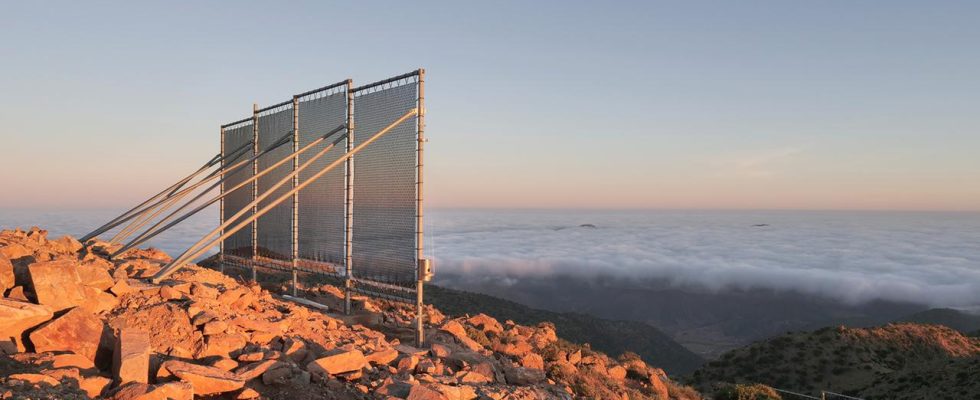world mirror
Nets that catch drops of water from passing clouds on mountains: an idea in the fight against drought. There are promising projects on the Canary Islands and Morocco.
When nets on Moroccan Mount Boutmezguida wrest tiny drops of water from clouds, a huge background noise is created. Strong wind pushes wisps of clouds through nets attached to steel girders on the 1,200-meter-high mountain.
It hisses and hisses. Then small drops form on thin plastic threads. They roll down the fabric, combine with other drops and finally fall into a gutter. On average, around 37,000 liters of water are collected on a cloudy night. There are around 90 of them every year.
Water drops: thick as a hair
Here, a good 30 kilometers from the Atlantic, the conditions for cloud catchers are ideal, says Peter Trautwein. Because the wind usually blows at a speed of 20 to 40 kilometers per hour. “And because the water droplets at this point are 20 to 40 micrometers in size. That’s roughly the cross-section of a hair.” Drops of this size were particularly easy to catch in the nets.
Droplets from passing clouds get stuck on tiny plastic threads. Some villages are already being supplied with water.
Trautwein is an industrial designer. He has designed ski boots and tennis rackets in his life. On his 50th birthday, he felt the desire to develop something completely different, “something that would really benefit people.”
So he ended up – on the edge of the Sahara – in a bone-dry area in Morocco and spent two years experimenting with the Technical University of Munich on nets that catch water droplets. German foundations and the Federal Ministry for Cooperation and Development financed the project.
16 villages live on cloud water
This year, Peter Trautwein was back at Mount Boutmezguida for the first time since setting up the cloud catchers in 2018 to see whether the nets would do what he had hoped. And in fact: around 1,000 people in 16 villages live from the water produced on the mountain from passing clouds. If the cloud catchers weren’t in their way, the clouds would move further towards the Sahara and evaporate. Rain often only occurs once or twice a year in the region. The Moroccan organization Dar Si Hmad is now taking care of the fair distribution of the water, which is piped directly to houses and huts.
Girls’ lives in particular have changed here. They were usually the ones who had to fetch water for the families in the morning. They spent hours at the well and on the way there. Many people now have time to learn to read and write. 17-year-old Hasna says that with the cloud catchers the time of suffering will come to an end. “We no longer have to work terribly hard. And we no longer have to think about where to get donkeys or vessels to carry water.”
In Gran Canaria, researchers are also experimenting with cloud catchers that are modeled on conifers. This means that 570 liters of water can be obtained per square meter per year.
Drought topic at climate conference
Increasing drought is likely to be one of the top topics at the UN climate conference COP28 in Dubai, which begins on Thursday. Two billion people worldwide do not have safe access to clean drinking water. And the situation is likely to get worse.
The Intergovernmental Panel on Climate Change assumes that North Africa will lose around 50 percent of its available surface water this century. There are similar forecasts for Spain. Studies say that up to 75 percent of Spain is at risk of desertification.
Water shortage is still a big problem in Spain even now – in November. There are villages in the south of the country that have been supplied with tankers since Easter. Since then, there has been no more drinkable water coming out of the pipes. Research into alternative water sources is therefore also an issue on the Iberian Peninsula.
Climatologist Victoria Marzol is researching in Tenerife which types of nets are most effective at extracting water droplets from passing clouds.
Reforestation on Gran Canaria
The European Union is funding the “Life Nieblas” project to learn more about the potential of cloud catchers. In the north of Gran Canaria, researchers have managed to capture tens of thousands of liters of water per year from passing clouds. They use simpler nets than in Morocco. But the goal is also more modest. On the Canary Islands, the water is successfully used to reforest a burned-out forest area.
In the book “Unconventional Water Resources,” scientists call for thinking about using unusual water sources. One of their suggestions: cloud catchers.
You can see these and other reports in Weltspiegel – on Sunday, November 26th, 2023, at 6:30 p.m. on Erste.

